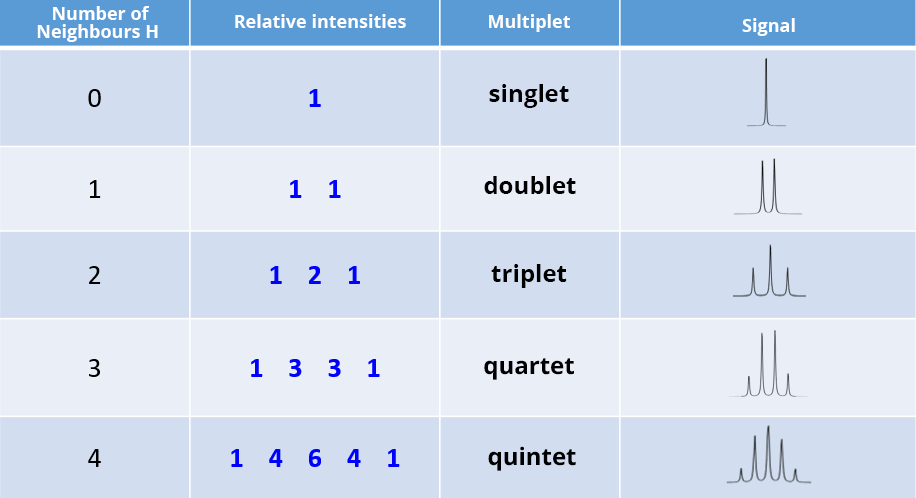Coupling constants J(Hz) and multiplicity
When observing a proton spectrum, even a very simple one like that of ethanol, we can see that the signals of each proton or group of protons (CH3, CH2 and OH) do not resonate to give a simple signal to only one line. The signals observable on an NMR spectrum of the proton show a so-called multiplet structure which is very informative for determining a structure but can be very complex.
Origin of multiplicity:
An HA proton (spin of ½) has two orientations in the B0 field (parallel to B0 level ↑α and antiparallel to B0 level ↓β). This nucleus locally creates a small magnetic field ΔB that adds to B0 when the orientation of the spin is parallel to B0 (α => B0 = B0+ΔB) and subtracts from B0 for the antiparallel orientation (β => B0 = B0-ΔB). An HX proton adjacent to HA is therefore subject to two field values and resonates at two very close but different frequencies. The observed signal consists of two lines. The multiplicity of the signal is a doublet. In this case it is said that HA is coupled to HX. The difference in frequency between the lines is the spin-spin coupling constant (JAX) and is expressed in Hz. The coupling constant is reciprocal, therefore HA is coupled to HX with the same coupling constant J and will resonate as a doublet if its only neighbor is HX.

The interaction between these two protons is a magnetic interaction that is transmitted via chemical bonds. The values of the coupling constants J (Hz) are independent of the B0 field and depend on the number of chemical bonds, the dihedral angle (Ψ) and the nature of the bonds separating the coupled protons. They are therefore characteristic of the structure of the compounds.
Multiplicity of signals
Case of an HA proton (or group of equivalent protons) coupled to several neighbors n with the same coupling constant.
The number of HA signal lines is given by the formula: 2nI+1 (with n the number of neighbors that couple with HA and I their spin number). In the case of the proton and the ½ spin nuclei, the formula becomes: n+1.
Example: a proton HA couples with 3 equivalent protons HX (e.g. CH3). The number of lines in the HA signal is 4, the multiplicity is a quartet and the distance between the 4 lines is identical and represents the coupling constant JAX.

The relative intensity of the lines of a multiplet resulting from a coupling to n protons of spin ½ and with the same coupling constant is given by by Pascal’s triangle.
Case of a proton (or group of equivalent protons) coupled differently to several neighbors - case of two different coupling constants.
If the above case is taken up (HA coupled to 3 HX with the same JAX coupling constant) and it is considered that HA is additionally coupled to another HM proton with a coupling constant JAM (≠ JAX), then the multiplicity of the signal of HA is a quadruple doublet with the doublet constant JAM and a quartet constant JAX.

Depending on the value of the two coupling constants the signal can appear very different:

Note: it is possible that, incidentally, JAX = JAM. In this case, the HA signal will be a quintet since HA is coupled with 4 neighbors with the same coupling constant.







